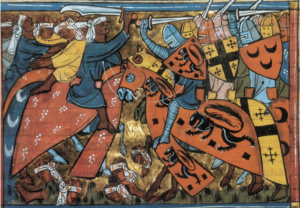[This post was written in the spring 2018 semester for Karrie Fuller's course on Chaucer’s Canterbury Tales. It responds to the prompt posted here.]
The idea of love is rather simple. However, artists from every specialty tend to exaggerate it in order to make it more exciting for their audiences. In other words, wild and adventurous love stories tend to garner more attention than timid, mundane ones. Life is not typically filled with love that takes people on an actual journey across the world and back, and the fantastic escapades that occur in literature and film are not common occurrences in the real world. Many novels that are popular today contain a chaotic love triangle or dramatic tale of love. However, such fantasies have always existed in people’s minds—several stories in Chaucer’s Canterbury Tales even demonstrate these ideas. Unfortunately, these types of stories are often glorified in a way that can be harmful. When these stories are written in ways that highlight a daring romance while ignoring the problematic parts of relationships, people are presented with a warped view of love. People are slowly made to believe that possessive and jealous lovers are attractive, or that self-loathing is sexy. Tropes like these should be reevaluated, or, at the very least, people should not be persuaded into believing that such tropes truly demonstrate an ideal form of love. I will focus primarily on the “Knight’s Tale” in light of how less than perfect ideas of love continue to be romanticized in today’s literature.
Throughout history, people have viewed knights in literature as chivalrous and noble men. When discussing the “Knight’s Tale”, however, some would argue that the knights, Arcite and Palamon, do not necessarily exhibit these traits, as they are not very considerate of the object of their affections, Emily. They function in their own world of fantasized love before Emily even knows they exist, and they do not honestly consider the situation from her point of view. The tale is set up to be rather romantic—two men fighting to the death for a woman’s love has often been considered an act of pure devotion. However, the romance in the “Knight’s Tale” is counteracted by the fact that Emily does not truly want to marry either of the knights (The Knight’s Tale 2304-2305). Her own desires are placed after everyone else’s, but the tale is considered romantic on the surface nonetheless. Essentially, the romantic ideals of protective knights and a beautiful woman are able to distract readers from the less-than-ideal treatment of Emily in which she is mostly ignored and forced into situations whether she likes it or not. Ashtin Ballard addresses Emily’s plight in regards to the oppression of her expressions in her essay as well, and this idea highlights the neglect Emily suffers throughout the “Knight’s Tale;” she is rarely able to discuss her woes, and no one seems to even want to hear about how she feels. Modern readers should be careful when reading to not accept this idea of love as ideal. Even if it is decorated with knights and princesses, it still contains many problematic aspects that continue into today’s literature—especially young adult fiction.
One of the more iconic love triangles of young adult fiction has its home in the popular Hunger Games trilogy by Suzanne Collins. This idea of competitive love resembles the one in the “Knight’s Tale,” and it is present in many other pieces from the young adult genre. Glorifying this trope could be problematic, though. Generally speaking, only one love interest ends up with the main character, but this indicates that the main character was meant to be won from the start. Nevertheless, people want to feel wanted, so the thought of two people fighting for one person’s affection is seen as exciting. It could be argued that if the main character has feelings for the love interests, then it is acceptable for such a rivalry to take place. I would argue, however, that this mainly works to make it more palatable to readers, and the idea of reducing a person to a prize is still present. Even if authors do not intend for this to happen, fans of books with this trope often make the rivalry into a competition. (See screenshot above of “Why Katniss Should Have Chosen Gale Over Peeta In the Hunger Games,” article by Mehera Bonner.) Thus, it is easy to see the connection between society’s romanticizing of competitive love and literature. Because the trope of the love triangle has evolved over time, people may write off Chaucer’s version as archaic, but it seems that today’s standards of love have not actually diverted that much from pieces considered outdated. People could learn a thing or two about unhealthy relationships if they understood where many of their beloved clichés gain inspiration.
To take it a step further, the idea of possessive lovers has become especially alluring. Similar to how Arcite and Palamon decide that Emily will belong to one of them, literature today contains characters that forcefully claim another (typically a young woman) as their own. A handful of people have claimed that abuse is romanticized in works like the Twilight saga by Stephenie Meyer. In her piece “Twilight: The Glamorization of Abuse, Codependency, and White Privilege,” Danielle N. Borgia argues that Edward’s “extreme dominance of his female partner is characterized as ideal masculinity” (Borgia 155). Likewise, the knights in the “Knight’s Tale” are often read as wonderfully noble men who embody true masculinity. When a possessive or jealous lover is idealized, people begin to honestly believe that such a lover is to be desired. Many readers of young adult fiction are very impressionable, so these ideas have the potential to twist their views of love and devotion into harmful ones. Therefore, Chaucer remains relevant because, even though people claim ideas set forth in tales like the “Knight’s Tale” are outdated, popular literature being published today often promotes the same ideas decorated in different ways.
The literary examples I have mentioned have been undeniably popular in the past few years, and it goes to show how society worships unhealthy relationships that are embellished to appear lovely. Even though people try to distance themselves from medieval ideas that they think are archaic, they unknowingly tend to enforce those ideas with only a few slight modifications. Readers should understand that some ideas from popular books are not new, so if they admire problematic love stories, then they run the risk of admiring the dynamics of stories like the “Knight’s Tale.” I think The Canterbury Tales is a useful text to compare modern works with, as people would be able to identify unsavory ideas in today’s writing if they could make connections to a text that they may already view as containing problematic sentiments. Unless society wants younger generations to think that possessive partners and abusive relationships are desirable as long as they are dressed up romantically, we should teach people where the romanticization of such ideas began and how it is perpetuated today.
Nicole Matthias
University of Notre Dame
Works Cited
Borgia, Danielle N. “Twilight: The Glamorization of Abuse, Codependency, and White
Privilege.” The Journal of Popular Culture, vol. 47, no. 1, 2011, Wiley Periodicals, Inc, pp.153-172. Wiley Online Library, www.onlinelibrary.wiley.com/doi/full/10.1111/j.1540-5931.2011.00872.x.
Chaucer, Geoffrey. “The Knight’s Tale.” The Canterbury Tales, 2nded., edited by Robert Boeing and Andrew Taylor, Broadview Press, 2012, pp. 63-95.
Collins, Suzanne. The Hunger Games.Scholastic Press, 2008.
Meyer, Stephenie. Twilight. Little, Brown and Company, 2005.




